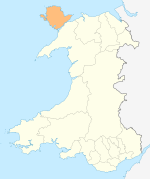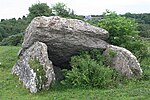Marian-glas

Marian-glas or Marianglas (Welsh pronunciation) is a small village and post town in Anglesey, north-west Wales. It lies between the larger villages of Moelfre and Benllech and just off the A5025. There is a large caravan park on the edge of the village and several camp sites. There is a church and pub but no shop. It has a memorial to those killed in the two world wars, including a list of 17 seamen from the Merchant Navy.Marian-glas Hut Group is an unenclosed hut circle (53.3379°N 4.2516°W / 53.3379; -4.2516 (Marian-glas Hut Group), SH501846). This Scheduled Ancient Monument (Cadw SAM No. AN093) is a roundhouse settlement dating at least back to Roman times. It is also called Cae Marh Hut Group. There are several huts with thick walls, some standing up to 1.4m high. Some of the huts' walls are now obscured by a thicket, while others are visible as wall lines in the lawns of Marianglas caravan park. The location is indicated on the ground through a signboard by the Ministry of Public Building and Works (which dates the sign to 1962–70).
Excerpt from the Wikipedia article Marian-glas (License: CC BY-SA 3.0, Authors, Images).Marian-glas
B5110,
Geographical coordinates (GPS) Address Nearby Places Show on map
Geographical coordinates (GPS)
| Latitude | Longitude |
|---|---|
| N 53.3346 ° | E -4.2478 ° |
Address
B5110
LL73 8PA , Llaneugrad
Wales, United Kingdom
Open on Google Maps









